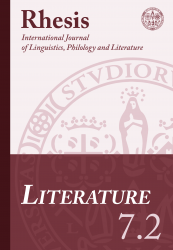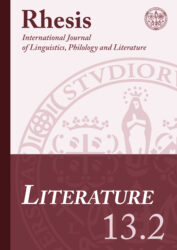 Literature
LiteratureVol. 7.2 - 2016
Download issue
Table of contents
| p. 5 | L’Éros substitutif dans La Fille aux yeux d’or de Balzac, ou l’enfer des jouissances médiatesJean-Marie RoulinAbstract Balzac’s novella, The Girl with the Golden Eyes engages in moral and philosophical reflection on desire in modern Parisian society. Forming a profound link between the novella’s prologue and the narrative of the passion shared by Paquita and Henri de Marsay, Balzac presents substitution as the commanding figure that dominates eros: the object of desire, which remains unattainable, yields to a substitute object; while parallel to this, the partner in the sexual relationship is always doubled by the image of an absent object of fantasy. Substitution also governs family relations: parents are putative fathers or adoptive mothers. These dynamics of substitution are based upon figures of resemblance and duality, of twinning and hybridity, of identity and otherness. This is the perspective from which the sibling relationship and female homosexuality are grasped. Thus, Balzac shows that pleasure in modern Parisian society always goes through mediation, that of a desired other, or through the mediation of gold. Mediated pleasure leads to deleterious or even infernal dynamics marked by an alienation characteristic of Parisian society in its quest for gold and pleasure.
|
| p. 18 | «Ciò che non ho potuto dire come pittore, l’ho detto come poeta, e ciò che non ho potuto dire come poeta, l’ho detto come romanziere». Ǧabrā Ibrāhīm Ǧabrā e i percorsi della creativitàLucia AvalloneAbstract Ǧabrā Ibrāhīm Ǧabrā, poet, novelist, painter, translator, literary and art critic, was one of the most significant figures in the Arab cultural landscape of the twentieth century. A Christian Palestinian exile in Iraq, he expressed the different aspects of himself through different means, each one supporting the other in a continuous creative effort. Author of short stories, novels and poems, he introduced into the Arabic culture works of Shakespeare, Beckett and Faulkner, and participated in the creation and development of the Arab Modernism both in literature and in painting. Member of the Baghdad Modern Art Group, he addressed the topic of identity, shaping a verbal and figurative aesthetics of the exile experience and the nation-building in an existentialist perspective, and promoting a progressive activism that has recovered the roots of civilization and tradition and was opposed to a quiescent traditionalism as one. Through a re-reading of what he produced dealing with various fields, this article aims to map the creative paths of Ǧabrā.
|
| p. 36 | Coloro che si considerano “eccezioni”: La desheredada di Benito Pérez GaldósGabriella CambosuAbstract This work aims at analyzing La desheredada by Benito Pérez Galdós from a psychoanalytic perspective. The main purpose consists in identifying the traits of character that Freud attributes to the so called “Exceptions” in its protagonist.
The author’s artistic economy, that does not enable the heroine to express her secret motives openly, leads to look for such traits in the narrator’s allusions to her character and in the attitudes attributable to those who consider themselves exceptions.
The analogies lie in the rebellion against the unavoidable submission to the rules of necessity by renouncing those satisfactions doomed to detrimental consequences, accepting sacrifice only for a better end’s sake. Faced with the necessity of exchanging the immediate pleasure for a safer one, Exceptions say that they have suffered and renounced enough, having thus the right to avoid any further self-denial and expect compensation for their sufferings.
These, in conclusion, are the desheredada’s secret motives, that the author hides in order to raise a subtle background of sympathy based on understanding and identification. Galdós’ heroine, actually, becomes a hyperbolic projection of something existing in everyone, because, deep down, we all would like to be an exception and claim more privileges than the others.
|
| p. 50 | L’Arabo Anziano (The Old Arab). A Forgotten Book by Yaʿqūb ṢanūʿAngela Daiana LangoneAbstract L’arabo anziano is a poem published in Cairo in 1869 and authored by Yaʿqūb Ṣanūʿ (1839 – 1912), an Egyptian Jew of Italian origins who is considered as one of the pioneers of the Arab theatre and one of the first Egyptian nationalists. The poem is a precious testimony for the time Ṣanūʿ spent in Livorno, Italy, and reflects his links with Freemasonry. This article intends to focus on the role of this poem for a comprehension of the rise of nationalism in Yaʿqūb Ṣanūʿ’s ideals and tries to shed light on his Italian experience through new unpublished documents found in the Historical Archives of the Jewish community of Livorno.
|
| p. 88 | At War with Mothers, Male Ego and their Words: Woolf’s Mrs. Dalloway and Lessing’s The Golden NotebookMonica SerraAbstract This paper concerns the analysis of the female identity in the Western world at the beginning of the twentieth century as constructed in the works of Virginia Woolf and Doris Lessing. Focusing the attention on the collapse of Western societies during the two World Wars, this study highlights the crisis of traditional patriarchal structures and the resulting emerging of new literary perspectives opposed to this system. Woolf and Lessing scrutinized the deep impact of social fragmentations on women’s identity by unveiling the failure of the patriarchal dominant society. Specifically, an attentive reading of the two novels Mrs Dalloway (1925) and The Golden Notebook (1962), is offered as an example of the de-construction of a dominant patriarchal language. The entire analysis is founded on the postulate that European women constituted for centuries a subculture developed under the shadow of patriarchy, and that in this context the portrayals offered by Woolf and Lessing should be considered as a significant achievement for women writing. On the basis of these examinations, it is concluded that the fragmented female identity drawn by the two authors represents the attempt to dismantle the overwhelming presence of a predominant patriarchal perspective during the two war times in Western societies.
|
| p. 108 | La Cort d’Amor tra le fonti del Roman de FlamencaAndrea MacciòAbstract The contribution deals with the relationship between the late-thirteenth-century Roman de Flamenca, a masterpiece of the medieval Occitan narrative, and the lesser-known allegorical poem La Cort d’Amor. Until now, in spite of an isolated recall of U. Limacher-Riebold, criticism seems to have eluded a systematic comparison between the two works, from which their direct contact emerges clearly not only because of the numerous textual coincidences, but more for the widespread and continuous correspondence (defined by Segre as an “intertextual stickiness”) between thematic concordances and verbal mentions: a clear evidence of the strong influence of a text to another. A validation of our thesis is also the common critical stance of both literary works toward the ideology of the fin’amor, accompanied by the same solution to its possible renewal.
|
Tags: alienation, Andrea Macciò, Angela Daiana Langone, Arabic Literature, Balzac, Cort d’Amor, creativity, Desheredada, Doris Lessing, Egyptian Nationalism, eros, Exceptions, exile, Feminism, fin’amor, Freemasonry, Freud, Gabriella Cambosu, Galdós, homosexuality, identity, innovation, intertextuality, Jean-Marie Roulin, Jewish Communities, Lucia Avallone, mediation, Modernism, Monica Serra, Occitan philology, Patriarchy, Roman de Flamenca, substitution, The Girl with the Golden Eyes, Virginia Woolf, World War
 LiteratureVol. 7.2 - 2016
LiteratureVol. 7.2 - 2016
